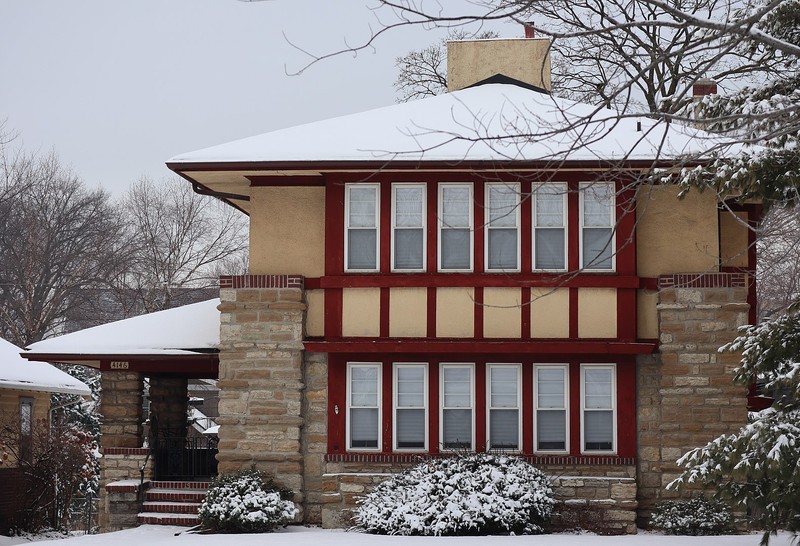Judge Louis Gates House
Introduction
Text-to-speech Audio
The historic Kansas City home was designed by Clarence Shepard, one of the area's most prolific architects who designed hundreds of Prairie School homes that reflected the work of his mentor Frank Lloyd Wright. Louis Gates was the first owner of the home and is known for leading efforts to establish public utilities, his work spearheading bridge construction, and his many years of service to the community as an elected official and judge.
Images
Judge Louis Gates House

Backstory and Context
Text-to-speech Audio
Constructed from 1922 to 1923, this Kansas City home is a fine example of Prairie School residential design adapted to the small suburban house lot. The home was designed by local architect Clarence E. Shepard who previously worked at the Frank Lloyd Wright studio in Chicago. The accomplished Judge Louis Gates, who filled several public roles, was its original owner and lived in the house for several decades.
Architect Clarence Shepard was born in Cortland, New York, in 1869, and moved with his family to Clay Center, Kansas, in 1880 before moving again to Chicago in the early 1890s. Shepard attended the University of California in 1895 before returning to Chicago in 1900. From 1902 to 1905, Shepard worked as a draftsman in Frank Lloyd Wright's suburban (Oak Park) studio. During these years, Shepard practiced the art of home designs, including the Prairie Style. In 1901, Shepard married the daughter of a Kansas City realtor and in 1907, the couple moved to Kansas City and Shepard opened a private architectural office. There, he gained a reputation as the area's foremost Prairie Style designer; he designed more than six hundred homes in the Kansas City area.
By the time Shepard designed the Gates house, the peak of Praire School designs had passed and had evolved to include inspiration from other architectural philosophies. Thus, the Gates house resembles later Prairie School designs that emerged after 1914. Judge Gates' house resembles work done by Frank Lloyd Wright, including features that allow for a small, private lot without unnecessary intricacy or artifice. For example, the garage sits beneath the porch, making room at the rear of the house for a service yard.
Gates received a B.A. degree from Baker University in Ottawa, Kansas, and a law degree from the University of Michigan and in 1910, he was admitted to the bar in Kansas City, Missouri. Gates decided to serve in the military during World War I, and when he returned from Europe, he opened an office In Kansas City, Kansas, and remained a solo practitioner during most of his career.
Gates and his family moved into this newly-constructed home in 1923, and in that same year, he secured a seat in the legislature as a representative of the Rosedale community, where he attended high school. One year prior, he had served as the Rosedale City Attorney to aid its consolidation with Kansas City, Kansas. Gates also figured prominently in the siting and building of the Rosedale World War I Memorial Arch. From 1925 to 1929, he was the judge of City Court, which he followed by taking on the role of a Wyandotte County counselor for one year. In 1931, Gates served as president of the Kansas City, Kansas, Chamber of Commerce and played an integral role in developing the Seventh Street Trafficway linking Rosedale to the northern portions of Kansas City, Kansas, and establishing the Kansas City, Kansas, Board of Public Utilities. In 1937, the local bar association elected him president. From 1938-to 1943, Gates was an intermediary in United States bankruptcy hearings.
The historic Gates house stands as a monument to several influential people. The home's architect, Clarence Shepard, developed into one of Kansas City's most prolific architects while the home's first resident, Judge Gates, left his mark on the Kansas City area by serving public positions.
Sources
Jacobs, Peregrine. "Judge Louis R. Gates Residence, 1922-23." docplayer.net. 2017. https://docplayer.net/26953095-Judge-louis-r-gates-residence.html.
Wortman, Julie, A. and Dale Nimz "Nomination Form: Judge Louis Gates House." National Register of Historic Places. nps.gov. 1980. https://npgallery.nps.gov/NRHP/GetAsset/NRHP/80001477_text.
"The Wright Stuff: Prairie Style Homes on the Prairie." Kansas Historical Society. Accessed March 14, 2022. https://www.kshs.org/resource/ks_preservation/kpjulaug04prairie.pdf.
By Self-created photograph by Jonathunder - Own work, GFDL, https://en.wikipedia.org/w/index.php?curid=66280998
